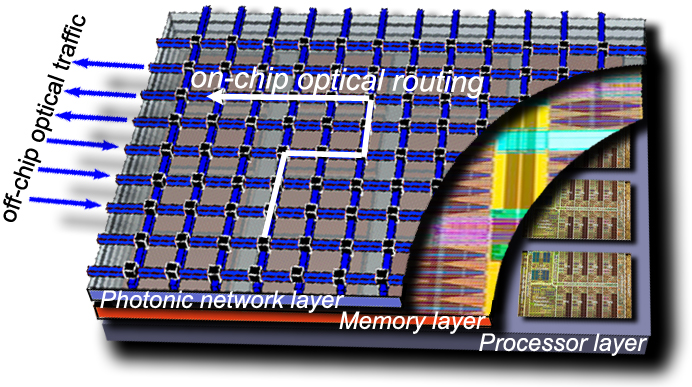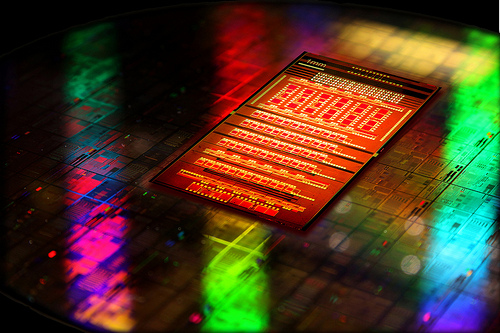Breakthrough Chip Technology Lights the Path to Exascale Computing
December 2, 2010
IBM scientists Wednesday unveiled a new chip technology that integrates electrical and optical devices on the same piece of silicon, enabling computer chips to communicate using pulses of light (instead of electrical signals), resulting in smaller, faster and more power-efficient chips than is possible with conventional technologies.
The new technology, called CMOS Integrated Silicon Nanophotonics, is the result of a decade of development at IBM’s global Research laboratories.
The patented technology will change and improve the way computer chips communicate — by integrating optical devices and functions directly onto a silicon chip, enabling over 10X improvement in integration density than is feasible with current manufacturing techniques.
IBM anticipates that Silicon Nanophotonics will dramatically increase the speed and performance between chips, and further the company’s ambitious Exascale computing program, which is aimed at developing a supercomputer that can perform one million trillion calculations—or an Exaflop—in a single second. An Exascale supercomputer will be approximately one thousand times faster than the fastest machine today.
“The development of the Silicon Nanophotonics technology brings the vision of on-chip optical interconnections much closer to reality,” said Dr. T.C. Chen, vice president, Science and Technology, IBM Research. “With optical communications embedded into the processor chips, the prospect of building power-efficient computer systems with performance at the Exaflop level is one step closer to reality.”
Suite of integrated ultra-compact active and passive silicon nanophotonics devices

Artist’ concept of 3D silicon processor chip with optical IO layer featuring on-chip nanophotonic network (IBM)
In addition to combining electrical and optical devices on a single chip, the new IBM technology can be produced on the front-end of a standard CMOS manufacturing line and requires no new or special tooling. With this approach, silicon transistors can share the same silicon layer with silicon nanophotonics devices. To make this approach possible, IBM researchers have developed a suite of integrated ultra-compact active and passive silicon nanophotonics devices that are all scaled down to the diffraction limit – the smallest size that dielectric optics can afford.
“Our CMOS Integrated Nanophotonics breakthrough promises unprecedented increases in silicon chip function and performance via ubiquitous low-power optical communications between racks, modules, chips or even within a single chip itself,” said Dr. Yurii A. Vlasov, Manager of the Silicon Nanophotonics Department at IBM Research. “The next step in this advancement is to establishing manufacturability of this process in a commercial foundry using IBM deeply scaled CMOS processes.”
By adding just a few more processing modules to a standard CMOS fabrication flow, the technology enables a variety of silicon nanophotonics components, such as: modulators, germanium photodetectors and ultra-compact wavelength-division multiplexers to be integrated with high-performance analog and digital CMOS circuitry. As a result, single-chip optical communications transceivers can now be manufactured in a standard CMOS foundry, rather than assembled from multiple parts made with expensive compound semiconductor technology.
The density of optical and electrical integration demonstrated by IBM’s new technology is unprecedented – a single transceiver channel with all accompanying optical and electrical circuitry occupies only 0.5mm2 – 10 times smaller than previously announced by others. The technology is amenable for building single-chip transceivers with area as small as 4x4mm2 that can receive and transmit over Terabits per second that is over a trillion bits per second.
The research history
The development of CMOS Integrated Silicon Nanophotonics is the culmination of a series of related advancements by IBM Research that resulted in the development of deeply scaled front-end integrated Nanophotonics components for optical communications. These milestones include:
- March 2010, IBM announced a Germanium Avalanche Photodetector working at unprecedented 40Gb/s with CMOS compatible voltages as low as 1.5V. This was the last piece of the puzzle that completes the prior development of the “nanophotonics toolbox” of devices necessary to build the on-chip interconnects.
- March 2008, IBM scientists announced the world’s tiniest nanophotonic switch for “directing traffic” in on-chip optical communications, ensuring that optical messages can be efficiently routed.
- December 2007, IBM scientists announced the development of an ultra-compact silicon electro-optic modulator, which converts electrical signals into the light pulses, a prerequisite for enabling on-chip optical communications.
- December 2006, IBM scientists demonstrated silicon nanophotonic delay line that was used to buffer over a byte of information encoded in optical pulses – a requirement for building optical buffers for on-chip optical communications.
The details and results of this research effort will be reported in a presentation delivered by Dr. Yurii Vlasov at the major international semiconductor industry conference SEMICON held in Tokyo on the December 1, 2010. The talk is entitled “CMOS Integrated Silicon Nanophotonics: Enabling Technology for Exascale Computational Systems” co-authored by William Green, Solomon Assefa, Alexander Rylyakov, Clint Schow, Folkert Horst, and Yurii Vlasov of IBM’s T.J. Watson Research Center in Yorktown Heights, N.Y. and IBM Zurich Research Lab in Rueschlikon, Switzerland.
Additional information on the project can be found at http://www.research.ibm.com/photonics.
Adapted from materials provided by IBM Research
